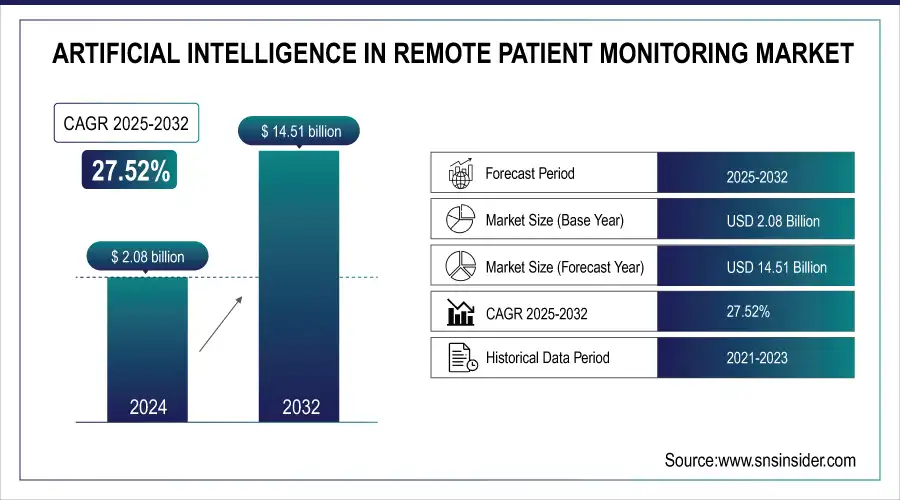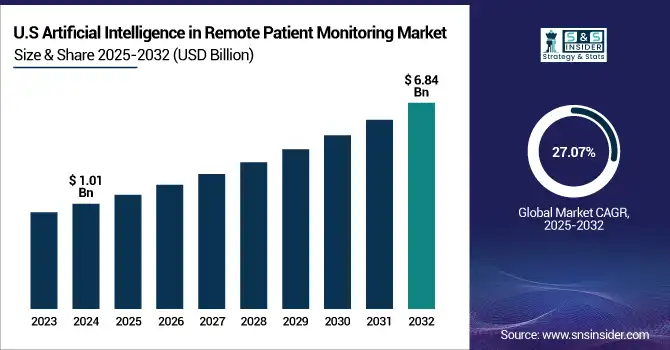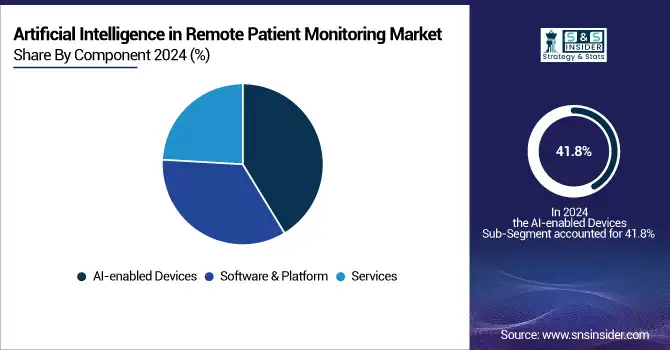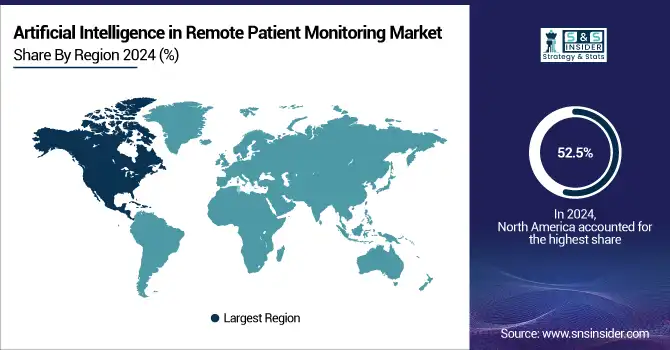Artificial Intelligence in Remote Patient Monitoring Market Report Size Analysis:
The Artificial intelligence in the Remote Patient Monitoring Market size was valued at USD 2.08 billion in 2024 and is expected to reach USD 14.51 billion by 2032, growing at a CAGR of 27.52% over the forecast period of 2025-2032.
The artificial intelligence in the remote patient monitoring market is witnessing strong growth owing to the increasing occurrence of chronic diseases, geriatric populations need for live health information. AI bolsters predictive analytics, providing providers the ability to identify individuals who need early intervention to prevent adverse outcomes using a data-driven approach from home rather than a hospital. Machine learning with wearables and cloud platforms will bring about widespread adoption both in home care and throughout the health care system. Government backing, digital health measures, and availability of superior AI technologies are additional propellers for market growth across the evaluation period through to 2032.

To Get more information on Artificial intelligence in the Remote Patient Monitoring Market - Request Free Sample Report
The U.S. artificial intelligence in remote patient monitoring market size was valued at USD 1.01 billion in 2024 and is expected to reach USD 6.84 billion by 2032, growing at a CAGR of 27.07% over the forecast period of 2025-2032. North America's artificial intelligence in the remote patient monitoring market is dominated by the largest revenue share of the U.S. This is due to a developed health IT infrastructure, large investments in AI R&D, and large tech and health companies. In the U.S., regulatory practices and reimbursement policies have also enabled the uptake of AI-based RPM solutions.

Artificial Intelligence in Remote Patient Monitoring Market Dynamics:
Drivers:
-
Transition to Value-Based and Patient-Centric Care is Propelling Market Growth
The transition of healthcare systems globally from classical fee-for-service systems to value-based care emphasized the priority for outcomes, efficiency, and patient satisfaction. This incentive structure pays providers based on the number of illnesses they prevent, rather than on a basis of fee-for-service basis. AI is the most essential tool when it comes to remote patient monitoring as it processes a large volume of patient-specific data, makes advanced predictions of patient status or risk, and enables you to determine if and when intervention is required. A more proactive approach can bring better clinical outcomes, reduced costs, and a better fit with value-based care.
-
AI and Wearable Technologies Advances are Driving the Market
Various artificial intelligence (AI) technologies, including machine learning, deep learning, natural language processing, and more, are rapidly evolving, providing higher efficiency to remote monitoring systems and improving the accuracy of intelligent systems. Deployment of smart wearable devices (smartwatches, biosensors, and fitness trackers) has further enabled continuous collection and transmission of real-time health data. Used along with AI algorithms, this equipment can identify anomalies, alert health practitioners, and even forecast medical events, thus making telehealth accurate, useful, and fast.
For instance, Masimo's W1 Medical Watch which was granted FDA clearance in August 2024 for use as part of the Masimo SafetyNet Telemonitoring System for continuous real-time health monitoring.
Restraints:
-
High Implementation and Maintenance Costs are Restraining the Market from Growing
Implementing an AI-powered remote patient monitoring system takes time and upfront capital expenditure. Healthcare enterprises require huge investments to purchase and integrate AI-managed devices with existing hospital systems and to develop supporting IT infrastructure. In addition, ongoing maintenance, software updates, data storage, cybersecurity, and technical support add operational costs frequently. While these technologies will ultimately provide substantial long-term clinical and operational benefits, the cost placed on many smaller hospitals, outpatient clinics, and providers who practice in lower-income or rural areas can be substantial and impede broad adoption.
The average implementation cost of RPM systems for hospitals ranges from USD 50,000 to USD 200,000, depending on size and complexity. Additionally, 70% of healthcare organizations identify cost as a primary barrier to RPM adoption.
Artificial Intelligence in Remote Patient Monitoring Market Segmentation Analysis:
By Component
The AI-enabled devices segment dominated the artificial intelligence in the remote patient monitoring market and accounted for 41.8% of the artificial intelligence in the remote patient monitoring market share in 2024, as advanced wearable devices, biosensors, and smart health monitors are rapidly acquiring embedded AI used for data collection and analysis in real-time. Continuous monitoring of vitals and health conditions, enabling timely intervention and better outcomes, are some of the benefits these devices provide. However, the unprecedented rise of chronic diseases and consumer preference for distance health management has further expanded the installation of AI-enabled devices in almost all hospitals and home care, laying roots in the market.
The services segment is anticipated to experience the fastest growth rate during the forecast years, driven by the increase in demand for AI-enabled remote monitoring platforms, data analytics, and customized healthcare solutions. AI-driven models can now be deployed in healthcare with dynamic services for predictive analytics, patient contact, and remote care management that need continuous support and tailoring. As AI technologies continue their upward surge, the segment for services including software updates, integration, and managed services will be increasingly associated with this growth within the artificial intelligence in remote patient monitoring market analysis.

By Technology
In 2024, Natural Language Processing dominated the artificial intelligence in the remote patient monitoring market with a 28.6% share due to Analysis of unstructured clinical data, such as explanations of physicians, patient feedback, voice instructions, and sentiment analysis, critically depends on NLP. By transforming the spoken or written word into something actionable, NLP opens doors to improved communication between patients and providers, ultimately resulting in better patient engagement and timely decision-making. The possibility of combined use with virtual assistants and chatbots is another reason for its large implementations in remote patient monitoring systems.
The Machine Learning (ML) segment is projected to register the fastest growth during the forecast period, owing to its ability to accurately predict and continually adapt based on large sets of data. By analyzing patterns and trends in patient data, ML algorithms help increase accuracy in disease detection, risk stratification, and personalized treatment recommendations. Growing emphasis on proactive and preventive care is pushing healthcare providers to explore advanced ML models, which can grow and adapt to changes and complexities paving the way to become the fastest growing segment of artificial intelligence in the remote patient monitoring market trends.
By Application
The diabetes management segment dominated the artificial intelligence in remote patient monitoring market with a 21.4% market share in 2024, which is attributed to the high global prevalence rate of diabetes, diabetes has also become a major reason for chronic diseases globally and there is a need to continuously monitor the level of glucose in blood, food intake and medication adherence. Remote monitoring devices and platforms enabled by AI, AI-based solutions, and providers for healthcare industry technology. Such capabilities minimize hospital visits and complications, which in turn, transform these tools into a requirement for patients and healthcare providers-especially in diabetic management-leading the segment in the market.
The mental health & behavioral monitoring segment is expected to grow at the fastest growth rate during the forecast period owing to increasing awareness about mental health concerns and the high burden of stress, anxiety, and depression globally. The increasing adoption of AI technologies to track mood patterns, behavioral changes, and psychological indices remotely with smartphones, wearables, and virtual assistants is embracing this trend. This segment is rapidly growing as the need for personalized mental healthcare approaches grows, with a focus on AI in teletherapy and digital interventions.
By End Use
In 2024, the hospitals & health systems segment dominated the artificial intelligence in remote patient monitoring market with a 28.52% market share 2024, owing to the availability of the required patient monitoring infrastructure and requisite technological capabilities and capital for healthcare providers to adopt advanced and integrated monitoring solutions with artificial intelligence. With high patient volumes, the need to shorten readmissions, continuous monitoring for critical and chronic conditions, and the eventual development of patient monitoring platforms, hospitals are increasingly turning to AI. AI incorporation with electronic health records (EHRs) and hospital information systems further extends the advantages of clinical decision-making, which is why hospitals are the largest proponents of AI-based remote patient monitoring technologies.
The home healthcare providers segment is anticipated to register the fastest growth throughout the forecast timeline as a result of rising inclination toward decentralized and patient-centered care. As aging populations, chronic disease management, and post-operative recovery outside of stuck clinical environments all escalate, the need for remote monitoring tools that allow care delivery to continue in-home has increased. Home health care providers are now using AI-powered platforms and artificial Intelligence-based wearable devices that enable real-time monitoring, potential early detection of complications, and personalized care plans, enhancing healthcare efficiencies and resulting in better patient outcomes at a lower overall cost of care delivery.
Regional Analysis:
North America dominated the artificial intelligence in remote patient monitoring market with a 52.5% market share in 2024, owing to an established healthcare infrastructure, the presence of major artificial intelligence and healthcare companies, and the high adoption of digital health technologies in this region. The region has significant investment in AI R&D, positive reimbursement policies, and favorable government efforts in support of telehealth and remote monitoring. The U.S. takes the lead with an established regulatory ecosystem, high healthcare provider awareness, and the widespread availability of wearable and connected health devices.

Get Customized Report as per Your Business Requirement - Enquiry Now
Asia Pacific is the fastest-growing region in the artificial intelligence in remote patient monitoring market share of 28.47% in 2024, due to increasing healthcare demands, a high burden of chronic disease, and rapid digital transformation across emerging economies such as China, India, and Southeast Asia. Governments across the region are heavily investing in digitisation to bring healthcare forward, and smart hospital infrastructure, while increasing smartphone penetration and access to the internet make remote monitoring a more manageable and affordable phenomenon. The growing emphasis on cost-effective and scalable healthcare delivery models is also propelling the uptake of AI-enabled RPM solutions in the Asia Pacific.
Europe is also holding a powerful share in the growth of Artificial Intelligence in the Remote Patient Monitoring market due to early governmental support, large investments, and sufficient healthcare infrastructure. The U.K. and Germany are at the forefront of this growth, with the U.K. AI Opportunities Action Plan and AI Growth Zones. In particular, Germany accounted for the biggest market share across Europe in 2024, owing to rising investments in healthcare technology and positive government initiatives. Moreover, the region has growing potential for the adoption of digital health, and strategic partnerships among industries are streamlining the implementation of AI-assisted monitoring devices.
Europe's proactive regulatory environment and prominent market players also contribute to the effectiveness of AI technologies in driving the artificial intelligence in remote patient monitoring. For instance, Luscii healthtech B.V., based in the Netherlands, has created an AI-based app, Luscii vitals, provided within approximately half of the Netherlands' hospitals to facilitate the management of patients outside of the hospital. These innovations, along with the focus on using technology for better patient care across the region, make Europe one of the major shareholders in the expansion of AI in the RPM market globally.
The growth of Latin America and Middle East & Africa (MEA) for artificial intelligence in the remote patient monitoring market is moderate as healthcare demands continue to grow and digital transformation initiatives continue making advances. Rising investments in AI-based healthcare solutions and increased interest around telemedicine platforms are facilitating AI adoption in Latin America, with Brazil being at the forefront, led by government support and technological advancements.
The MEA, with its growing chronic disease prevalence, increasing geriatric population, and favorable government initiatives, is one of the growth drivers. Countries such as Saudi Arabia, the UAE are heavily investing in creating healthcare infrastructure and digital health programs as part of the Vision 2030 aspiration by Saudi Arabia.
Artificial Intelligence in Remote Patient Monitoring Market Key Players:
The key players in the market are Koninklijke Philips N.V., Medtronic plc, GE HealthCare, Dexcom Inc., Biofourmis Inc., Tunstall Healthcare, AliveCor Inc., Biobeat, Current Health, Dozee, and other players.
Recent Developments in the Artificial Intelligence in Remote Patient Monitoring Market:
-
April 2024, Royal Philips is a global leader in health technology, announced a strategic partnership to install smartQare's solution, viQtor, onto Philips' world-class clinical patient monitoring platforms. Developed for next-generation continuous patient monitoring both in hospital and home environments, the partnership will initially roll out throughout Europe.
-
Sep 2023, FluidAI Medical, an award-winning global and local AI innovator and developer of the Stream Platform for post-surgical monitoring, provided news of a strategic partnership with Medtronic Canada ULC, a subsidiary of Medtronic PLC, a key global player in healthcare technology. This partnership aims to drive the Continuous Connected Patient Care (CCPC) initiative through Canada′s Global Innovation Cluster for digital technologies, the DIGITAL Global Innovation Cluster, to transform health care delivery across Canada.
Artificial Intelligence in Remote Patient Monitoring Market Report Scope:
Report Attributes Details Market Size in 2024 USD 2.08 Billion Market Size by 2032 USD 14.51 Billion CAGR CAGR of 27.52% From 2025 to 2032 Base Year 2024 Forecast Period 2025-2032 Historical Data 2021-2023 Report Scope & Coverage Market Size, Segments Analysis, Competitive Landscape, Regional Analysis, DROC & SWOT Analysis, Forecast Outlook Key Segments • By Component (AI-enabled Devices, Software & Platform, Services)
• By Technology (Machine Learning, Natural Language Processing, Speech Recognition, Others)
• By Application (Cardiovascular Monitoring, Diabetes Management, Respiratory Monitoring, Oncology Remote Monitoring, Mental Health & Behavioral Monitoring, Post-operative & Home Recovery, Elderly/Frail Patient Monitoring, Sleep Disorders & Neurological Monitoring, Others)
• By End Use (Hospitals & Health Systems, Home Healthcare Providers, Primary Care/Outpatient Clinics, Payers & Health Insurers, Healthcare Companies, Others)Regional Analysis/Coverage North America (US, Canada, Mexico), Europe (Germany, France, UK, Italy, Spain, Poland, Turkey, Rest of Europe), Asia Pacific (China, India, Japan, South Korea, Singapore, Australia, Rest of Asia Pacific), Middle East & Africa (UAE, Saudi Arabia, Qatar, South Africa, Rest of Middle East & Africa), Latin America (Brazil, Argentina, Rest of Latin America) Company Profiles Koninklijke Philips N.V., Medtronic plc, GE HealthCare, Dexcom Inc., Biofourmis Inc., Tunstall Healthcare, AliveCor Inc., Biobeat, Current Health, Dozee, and other players.

